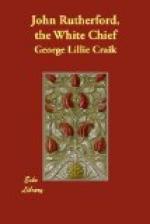Without attempting to theorise as to such a matter on the ground of such narrow views as ordinary experience would suggest, we may here state what the evidence is which we really have for the cannibalism of the New Zealanders.
Cook was the first who discovered the fact, which he did in his first visit to the country. The strongest proof of all was that which was obtained in Queen Charlotte Sound. Captain Cook having one day gone ashore here, accompanied by Mr. Banks, Dr. Solander, Tupia, and other persons belonging to the ship, found a family of the natives employed in dressing some provisions.
“The body of a dog,” says Cook, “was at this time buried in their oven, and many provision baskets stood near it. Having cast our eyes carelessly into one of these as we passed it, we saw two bones pretty cleanly picked, which did not seem to be the bones of a dog, and which, upon a nearer examination, we discovered to be those of a human body. At this sight we were struck with horror, though it was only a confirmation of what we had heard many times since we arrived upon this coast. As we could have no doubt but the bones were human, neither could we have any doubt that the flesh which covered them had been eaten. They were found in a provision-basket; the flesh that remained appeared manifestly to have been dressed by fire, and in the gristles at the end were the marks of the teeth which had gnawed them.
“To put an end, however, to conjecture founded upon circumstances and appearances, we directed Tupia to ask what bones they were; and the Indians, without the least hesitation, answered, the bones of a man. They were then asked what was become of the flesh, and they replied that they had eaten it; ‘but,’ said Tupia, ’why did you not eat the body of the woman we saw floating upon the water?’ ‘The woman,’ said they, ’died of disease; besides, she was our relation, and we eat only the bodies of our enemies, who are killed in battle.’
“Upon inquiry who the man was whose bones we had found, they told us that, about five days before, a boat belonging to their enemies came into the bay, with many persons on board, and that this man was one of seven whom they had killed.
“Though stronger evidence of this horrid practice prevailing among the inhabitants of this coast will scarcely be required, we have still stronger to give. One of us asked if they had any human bones with the flesh remaining upon them; and upon their answering us that all had been eaten, we affected to disbelieve that the bones were human, and said that they were the bones of a dog; upon which one of the Indians, with some eagerness, took hold of his own forearm, and thrusting it towards us, said that the bone which Mr. Banks held in his hand had belonged to that part of a human body; at the same time, to convince us that the flesh had been eaten, he took hold of his own arm with his teeth, and made a show of eating. He also bit and gnawed the bone which Mr. Banks had taken, drawing it through his mouth, and showing by signs that it had afforded a delicious repast. Some others of them, in a conversation with Tupia next day, confirmed all this in the fullest manner; and they were afterwards in the habit of bringing human bones, the flesh of which they had eaten, and offering them to the English for sale.”




